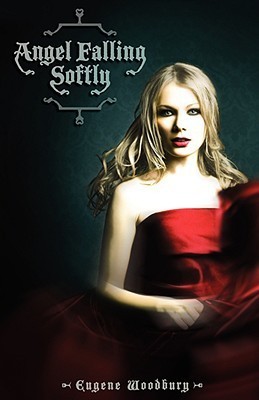[[2025-07-13: This post and its comments were lost in translation somewhere, and today I retrieved it and its comments from the Wayback Machine.]]
 Angel Falling Softly
Angel Falling Softly
by Eugene Woodbury
published by Zarahemla Books
Perhaps I should admit upfront that I consider myself an undemanding reader. I’ll happily go wherever the author wants to take me as long as it’s logical, consistent, and interesting. Let me add that I don’t even particularly care whether a story is plot-driven or character-driven; give me something to chaw on intellectually and I’m good to go. Make me laugh and I’ll forgive almost anything.
This is one reason why, when I read Stephenie Meyer’s Twilight I was highly annoyed. I like vampires. I’ve studied vampire myths since I fell in love with Vlad the Impaler somewhere in the early ’90s, so her inconsistent worldbuilding, her habit of telling rather than showing, and her mostly flat characterizations grated.
By contrast, Eugene Woodbury’s take is haunting. Poignant, even.
Rachel Forsythe is an LDS bishop’s wife who is drowning under the weight of the responsibilities tearing at her: a dying daughter and the latent grief of one daughter’s inevitable death, the need to give the other daughter the attention she needs, the burden of carrying on mostly alone while her husband tends to the needs of his congregation, not to mention the regular everyday duties of a mother and wife. Then she gets a new neighbor.
Milada is a vampire temporarily out of her element in a very sunny Salt Lake City to explore an investment opportunity. She lands herself in a cookie-cutter suburban neighborhood in a split-level ranch, surrounded by people she views as a bit odd, but nice. When Milada is invited to a barbecue at the bishop’s house and ends up saving a little boy’s life, her secret starts to unravel.
Once Rachel realizes and accepts what Milada is and understands the unique properties of her dining habits, she must decide how far she would go to save her daughter’s life.
This isn’t a vampire story. It’s a character study of the things we, as Latter-day Saints, might do when pushed into a corner with no apparent way out. It also asks if we have faith in what we say we believe.
The theme of the entire book can be summed up in one line. When Rachel presents her idea to Milada, Milada says: “Christians claim to believe in eternal life. So why are you so afraid of death, Rachel?”
I don’t know if Mr. Woodbury intended for the reader to believe Rachel’s answer, but I didn’t believe her. It doesn’t make any substantive difference, though; the effect would have been the same. At the end of the day, no matter how much faith we have, we do not know what happens to us when we die.
Rachel herself seems somewhat scattered and toward the middle of the book, it seemed I hadn’t heard much more about her dying daughter and I almost forgot she had one. Though that was corrected posthaste, I would have liked to see more distress at her daughter’s situation more consistently, and though I (as a mother) could appreciate that she was probably emotionally numb, I felt the daughter actually didn’t exist for a few chapters. I just don’t feel Rachel’s distress very deeply until she starts connecting Milada’s dots. That said, I do like Rachel and find her sympathetic.
With regard to this vampire’s world, I believed it. Mr. Woodbury gave me a different physiological and anatomical (i.e., plausible) reasons to believe that these creatures exist and how. Mr. Woodbury doesn’t shy away from the innate vampire-sex connection. He does not use the act of biting and drinking as a metaphor for sex, accidentally or otherwise; he makes a clear case that sex is necessary for the vampire to get her nutrients.
Mr. Woodbury also displays a sly humor that abuts worldly sensibilities to Mormon culture and deftly captures the irony. For instance, when Milada checks out the art her interior decorator chose, she muses: “Considering the milieu, Milada would have recommended O’Keeffe.”
I can’t say that the end was a surprise because there were only three logical ways it could have gone and any one of them would have been perfectly workable; two of them would have been relatively comfortable. He took the uncomfortable path. What I’d like now is a sequel to explore the fallout of that ending.
Mr. Woodbury does nothing the easy or expected way in this story. There are no Relief Society and Elder’s Quorum platitudes. She doesn’t consult her husband either as priesthood leader of the home or as bishop. Rachel makes a unilateral decision that has no precedent in LDS history or culture or doctrine; she doesn’t know if it’s wrong or right and she clearly doesn’t care, she doesn’t spend a lot of time dithering over the details of what could happen, and she doesn’t even pray about her decision. She acts quickly and on pure instinct, as any vampire ever did. There are a lot of questions in this book and almost no answers—and I liked that.
Moral ambiguity amongst faithful Mormons: More, please.

